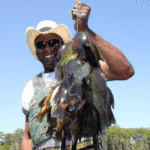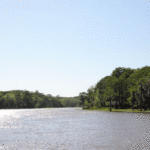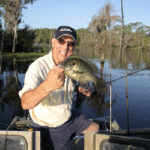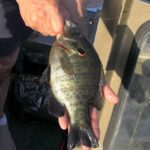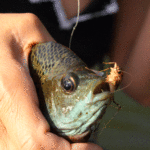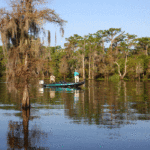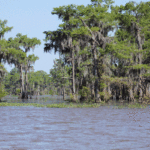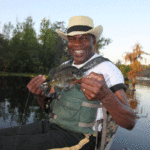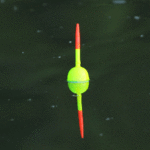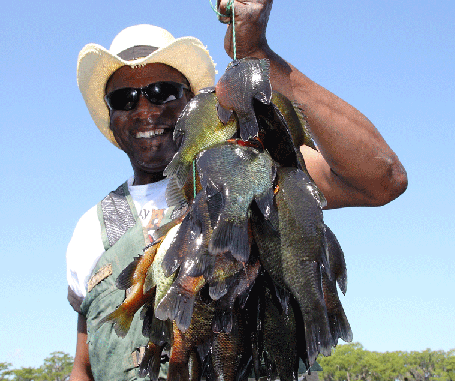
Why run miles into the Atchafalaya Basin when bull bream await in the short passes right off the Intracoastal Waterway?
In sort of a hypnotic, mesmerizing motion the tip of my float wavered left to right in a semi-circle until it slowly sunk beneath the surface of the water.
“What the heck kind of bite is this?” I said to my friend Raymond Delco while lifting the tip of my rod straight up.
The tug from the business end of the line was all that was needed to tell me what kind of bite.
This was a bull bream bite — just what we were after.
Lesser-sized bream, the kind where if you filleted them would only produce a potato-chip-size piece of meat, would just attack and run for cover for fear of being eaten.
Going for broke, the redeared sunfish dove deep beneath the thick grass along the bayou, where we were anchored in about 5 or 6 feet of water. I’d now have to fight both fish and grass.
If fish have any brains at all, this bream was using his.
“Del, he fights like a small version of a black drum you’d catch out in the bay,” I said, more talking myself through the process of making sure I didn’t try and manhandle the fish and ultimately break the line than looking for him to reply.
By not reeling at all and simply allowing the tension of my rod to put pressure on the fish, it finally gave up and came through the grass; a lesson learned after breaking many lines due to a lack of patience.
No sooner was the fish that stretched from fingertip to above my wrist in the boat than Delco’s float was sinking slowly in a repeat performance of mine.
“Ooooo, got him and he’s what-cha-call — a bull bream!” Delco said with a toothy grin that always reminded me of the actor Danny Glover’s.
Delco and I were fishing a little stretch of water in the Atchafalaya Basin called Bayou Grobec, which was tucked between Flat Lake and the levee where the Intracoastal Canal bypass runs.
It’s small water: shallow on the edges and tree-lined. But, most bream anglers know there are a lot of fish to be caught in 5 feet of water or less, so why pass up short shallow water bayous?
Bream congregate in the shallow water to spawn in June. This ritual occurs as often as three times a year due to Louisiana’s weather that can be in the 80s well into late October.
The thing is, the summer of 2012 just may be one of the best years in decades for big bream and, quite frankly, bass and crappie.
Mike Wood, director of the Department of Wildlife and Fisheries’ Inland Fisheries, told a group of outdoor writers during last August’s Louisiana Outdoor Writers Association conference in Houma that it’s easy for him to predict what anglers can expect as a result of last year’s flood and the previous high water events in the basin during 2008 and 2010.
“In most cases, a flood is the river — left to its nature — doing what the river does, and it’s a very important aspect that the river in the springtime does its thing, which is to rise above its banks,” Wood said. “When that occurs, it provides area for fish to spawn and provides areas for young fish to take refuge.
“And every time we have that we have a tremendous boost in reproduction. And so now, of course, this year (2011) was a record one we had this past year. We almost forget we had a very high flood the year before.”
These back-to-back floods bodes well for anglers.
“It’s easy for me to predict that the next two or three years, all throughout the Quachita drainage and throughout the Mississippi River drainage, we’re going to have great fishing, much like it was during the ’70s and ’80s,” Wood said.
Essentially, when fish get the chance to live and grow for two, three and four years, some stringers get to be pretty hefty.
And when the flooding that spread fish out all over the Basin recedes bream are concentrated in their normally occurring range.
Most anglers who fish regularly for chinquapins, bluegills and sac-a-lait when the water is in that normal range have their personal honey holes.
On their way to those tried-and-true areas, the anglers will typically pass up short stretches of water because they prefer long, winding bayous, lakes and canals found deeper in the Basin.
Short, shallow bayous like Grobec, which really and truly is nothing more than a short pass, aren’t often the first choice of Basin anglers — and therefore don’t get as much pressure.
On any given Saturday in the Basin there are lakes and bayous where boats are often anchored so close together you can nearly step boat to boat. And there’s nothing wrong with getting in amongst them, but there are other less-crowded short spots, such as the passes going into American and Duck Lakes, where you can catch bull bream.
The real message is don’t pass up short-water locations wherever you find them in the Basin. You might be surprised.
Bream, like other game fish, prefer some submerged structure. Find some semi-submerged logs along a shallow bank with a couple feet of water underneath and there is a strong likelihood you’ll catch bream.
Other structure to look for includes any deadfall where half of the stump is sticking up out of the water and the other half is submerged. Structural pylons supporting oilfield equipment, tree stumps, camp wharfs, are also likely locations for bream.
And, areas like the mouth of Grobec where it opens up into Flat Lake holds cypress trees that should be fished without fail.
Bream will bite on just about anything that wiggles, creeps, crawls or even looks edible. The moving water in the Basin is full of invertebrates fish feed on.
Anglers have caught chinquapins and bluegills using grubs, wax worms, trout worms and kernels of corn.
But nothing works like crickets.
That’s exactly what Michael Broussard, a young angler who frequents the Basin for sac-a-lait throughout the spring and summer, prefers bream.
“I’ll use a cricket suspended under a float,” the Berwick native and Eagle Scout said. “I’ll put a little split shot — something like 1/8 ounce — and place it just above the hook.
“That’s what works best for me.”
One of the keys to catching bull bream is to know when to move. At the base level, it’s actually something that isn’t hard to figure out. If you’re not catching anything — move.
But, it’s more than that.
If you’re using a wiggly worm or cricket, they usually are doing their job beneath the surface. Your float should show some activity in a few seconds — definitely less than a minute in good bream waters.
Longer than that and it’s time to move it.
Along the bayou bank Delco and I fished, the move was only a few feet at a time with our casts. We would cast our baited lines in a 100-foot-long stretch of bank between the boat and the thick submerged grass beds.
Small bream would aggressively tap-tap-tap, providing us with lots of action.
And, the big boys would slowly suck down the bait and fight hard when caught.
If we made a cast and didn’t catch a fish, we’d cast 15 or 20 feet away. It wasn’t long before we had 25 palm-size bluegills and chinquapins — several that measured well longer than my hand.
Bream also will bite a number of artificial baits such as marabou jigs, Uncle Buck’s Baby Bream Soft Baits, Uncle Bucks Tiny Creatures and the old standby Berkley/Johnson Beetle Spins.
Bream, compared to crappie, goggle-eye and bass, don’t have large mouths. So anglers should select 1/8-, 1/16-, and 1/32-ounce sizes of lures
The smaller and lighter the bait the better for bull bream.
Be aware, however, that these small micro baits can be difficult to cast with a standard rod and reel.
Anglers who fish for chinquapins and bluegills can use their universal 6-foot, 6-inch-long rods with 10-pound-test fishing line. While these rods are great for big catfish and even redfish, they aren’t very suited for tossing ultra light artificial baits.
So when using light artificial baits, be sure to match them with the tackle you’re using.
I’ll fish my personal favorite “poppa chop” jig for bream, but use my long crappie pole when doing it. The reel is loaded with 4- or 6-pound-test monofilament that is more suited for tossing small lures.
The heavier 6-pound line does handle big bull bream that bury themselves in the grass better, as it doesn’t tend to break as readily as 4-pound versions.
So the next time you plan your trip into the Basin, be sure to head them off at the passes and fish shallow water.
You just might find yourself with a stringer of bull bream caught from waters passed up by others.
